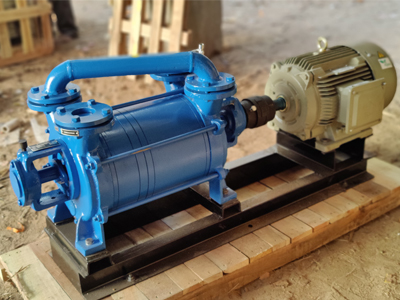Double Stage Vacuum Pump
 Make Enquiry
Make Enquiry
A double-stage vacuum pump is a type of vacuum pump designed to achieve deeper vacuums than single-stage pumps by using two separate pumping stages. The two stages work in tandem to reduce the pressure in the vacuum chamber more efficiently, especially in applications that require a high-quality or deep vacuum.
How a Double-Stage Vacuum Pump Works:
1. First Stage (Roughing Stage):
- The first stage operates as a roughing pump, which reduces the pressure in the system from atmospheric pressure (about 760 Torr) to a lower level, typically in the medium vacuum range (around 10–100 Torr).
- In this stage, the pump typically works by trapping and compressing air and gases, then pushing them out of the pump chamber.
- Common pumps used for this first stage include rotary vane or piston pumps.
2. Second Stage (High Vacuum Stage):
- Once the first stage has brought the pressure down to a level where a higher vacuum is achievable, the second stage further reduces the pressure, typically to the high vacuum range (0.005 MM Of HG and below).
- The second stage may use a similar pump design but typically operates at a lower speed and with more precision.
- In some designs, the second stage can be a turbo molecular pump, diaphragm pump, or roots blower that works to further evacuate the remaining gases to achieve a deeper vacuum.
Advantages of a Double-Stage Vacuum Pump:
1. Achieving Deeper Vacuums:
- Double-stage pumps are ideal for applications that require a deep or high vacuum, typically in the range of 0.005 MM Of HG or lower. They are much more efficient at achieving lower pressures compared to single-stage pumps.
2. Increased Efficiency:
- The two-stage design helps to reduce the total work the pump has to do in a single stage. The first stage handles the bulk of the gas removal, while the second stage fine-tunes the vacuum, leading to better efficiency and a faster pumping process.
3. Longer Pump Life:
- By splitting the workload between two stages, the pump typically experiences less wear and tear on individual components, leading to a longer service life.
4. Better Sealing and Reduced Oil Contamination:
- Double-stage pumps can create a better seal between the components, reducing the chance of leaks, and the second stage can further minimize oil contamination, especially if used with oil-sealed pumps.
Applications of Double-Stage Vacuum Pumps:
1. Scientific Research:
- Double-stage pumps are commonly used in laboratory environments, especially in high-energy physics, material science, and semiconductor fabrication, where high or ultra-high vacuum conditions are required.
2. Vacuum Distillation:
- Used in chemical processing or material testing where distillation or chemical reactions occur in a controlled vacuum environment.
3. Vacuum Coating and Deposition:
- Employed in industries where thin films are deposited onto substrates, such as in solar panel manufacturing, optical coating, or metal coating.
4. Electron Microscopy:
- Critical in electron microscopes and similar devices that need to maintain an ultra-low pressure in the sample chamber for clear imaging and research.
5. Freeze-Drying:
- In pharmaceutical and food industries, double-stage vacuum pumps are used for lyophilization (freeze-drying) processes, where a deep vacuum is necessary to remove moisture from sensitive products.
Advantages of Double-Stage Vacuum Pump over Single-Stage Pumps:
- Better Performance: Double-stage pumps typically provide deeper vacuums and better control over the pressure levels in applications requiring very low pressures.
- Faster Pump Down: By splitting the work between two stages, a double-stage pump can reduce the time it takes to reach a deep vacuum compared to single-stage pumps.
- Longer Operating Life: With reduced stress on each individual stage, these pumps tend to last longer and are less prone to breakdowns.
- Flexibility: They offer more flexibility in a variety of applications where different levels of vacuum are needed.
Maintenance Tips for Double-Stage Vacuum Pumps:
- Regular Oil Changes: If the pump is oil-lubricated, regular oil changes are essential to ensure proper performance and avoid contamination.
- Check for Leaks: Ensure that both stages are sealed properly to prevent air from entering the system, which could compromise the vacuum.
- Filter Maintenance: If the pump has any filters (e.g., oil filters or air filters), these need to be cleaned or replaced periodically to avoid clogging and maintain efficiency.
- Monitor Pressure Levels: Regularly check the pressure levels to ensure both stages are operating within optimal ranges and that the system is not underperforming.
